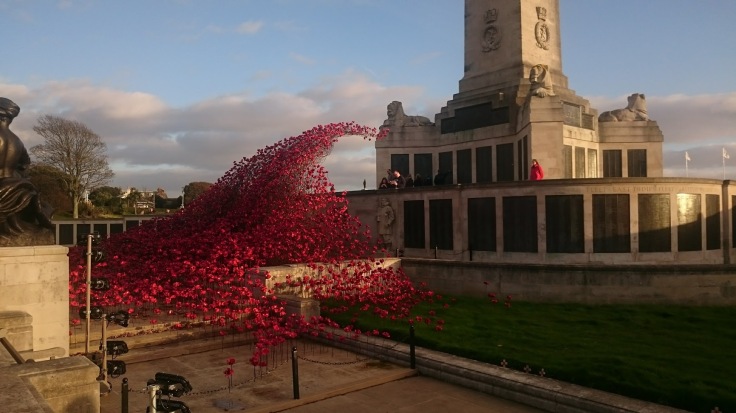Plymouth is a city that is synonymous with the Royal Navy due to its rich history as a naval port. As far back as 1690, Plymouth has hosted a naval dockyard. The port started to grow into its modern incarnation from the early to mid 19th century onward through various expansions. As an act of remembrance the Royal Navy commissioned three memorials in Plymouth, Portsmouth and Chatham for those who died at sea with no grave. The imposing obelisk on the hoe at Plymouth was completed in 1924.
During my days in the naval service, the war memorial was always a welcome sight after long periods away from the home port. On a recent visit to Plymouth I was further reminded of the sacrifices made by our previous generation of sailors at the memorial site thanks to the poppy sculpture.

I couldn’t help but be moved by this display of poppies that are temporarily connected to the memorial. This touring sculpture is helping to link people with with these war memorials in a contemporary manner in an act of remembrance. It can be so easy to walk on past static memorials. This sculpture will still be on display until the 19th November and I would actively encourage everyone in the Southwest to visit. The lighting at night time is said to be breathtaking as well.
Recently the poppy has found itself at the centre of some controversy. Sadly this is mainly due to various people and organizations with agendas that do not reflect the origins of the symbol. The poppy is a reminder of the scale of loss that a generation had never seen before, slaughter on a mechanical scale. The poppy’s symbolism was inspired by the poem by John McCrae:
In Flander’s Fields
In Flanders fields the poppies blow
Between the crosses, row on row,
That mark our place; and in the sky
The larks, still bravely singing, fly
Scarce heard amid the guns below.
We are the Dead. Short days ago
We lived, felt dawn, saw sunset glow,
Loved and were loved, and now we lie
In Flanders fields.
Take up our quarrel with the foe:
To you from failing hands we throw
The torch; be yours to hold it high.
If ye break faith with us who die
We shall not sleep, though poppies grow
In Flanders fields.
The connection between the poppy and Flander’s field marks the resting place of those who sacrificed their lives. The poppy is a physical reminder of the dead. Instead of quarreling or allowing the poppy to be abused by people it should be a reminder of the true cost of conflict. The poppy should make us explore and investigate the reasons why all these people laid their lives down. Their lives should not be gone in vein, if we don’t investigate the past or explore it we do those that lost everything an injustice. The poppy sculpture helps to remind us that we must not forget, these lives must not go wasted, but respected, perhaps now now more than ever.



Leave a comment